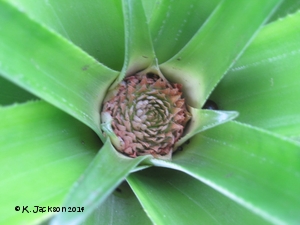Forcing a Pineapple to Flower  Fig. 1 Research has shown that the larger the pineapple plant is when it flowers, the larger the potential fruit produced. Removing developing slips and suckers will enhance the rate of growth of pineapple plants and reduce the time it takes them to become large enough to induce flowering and produce large fruit. Pineapple plants may be induced to flower by shortday lengths, cool/cold weather, and dry or drought conditions. To produce the biggest and highest quality pineapple fruit, cultural practices prior to full plant size should be aimed at keeping the plant in an active state of vegetative growth. This may be accomplished by frequent light applications of fertilizer and periodic watering. Neglected plants and plants exposed to prolonged drought or cold may be induced to flower early and therefore produce smaller fruit. 1 If you can find calcium carbide, perhaps in a hobby store, drop three or four small pellets into a cup of ice water. When the solution stops fizzing, pour it into the center of the rosette whorl of leaves. Naphthaleneacetic acid (about 7 mg per cup of water) poured into the rosette will also induce flowering. B-hydroxyethyl hydrazine (BOH) (5 ml per gallon) also works, as do other products that generate either acetylene or ethylene gas. The forcing treatment should be reapplied one week later. Because pieces of apple fruit generate ethylene gas and can be used to hasten ripening of bananas, it may be possible to induce flowering of pineapple by placing pieces of an apple on the rosette and adjacent leaf axils. I do not know if this will work. 2 As far back as 1936, compressed acetylene gas, or a spray of calcium carbide solution (which generates acetylene) were employed to expedite uniform blooming. Some growers have merely deposited calcium carbide in the crown of each plant to be dissolved by rain. A more advanced method is the use of the hormone, a-naphthaleneacetic acid (ANA) or B naphylacetic acid (BNA) which induce formation of ethylene. In recent years, B-hydroxyethyl hydrazine (BOH) came into use. Treatment is given when the plants are 6 months old, 3 months before natural flowering time. The plants should have reached the 30 leaf stage at this age. 3 Plants treated with naphthaleneacetic acid produce long, cylindrical, pointed fruits, maturing over an extended period of time, ripening first at the base while the apex is still unripe. Ethylene treatment results in a square shouldered, shorter fruit maturing over a shorter period and ripening more uniformly. 3 The time from flower induction to fruit harvest ranges from 5 to 7 months depending upon variety, weather, and cultural practices. Back to Pineapple Page |
|
| Bibliography 1 Crane, Jonathan. "Pineapple Growing in the Florida Home Landscape." edis.ifas.ufl.edu. One of a series of the Horticultural Sciences Department, Florida Cooperative Extension Service, Institute of Food and Agricultural Sciences, University of Florida. 1975. Reviewed July 2013. Reviewed Dec. 2019. Accessed 26 Dec. 2013, 13 Apr. 2020. 2 Sauls, Julian W. "Home Fruit Production - Pineapple." aggie-horticulture.tamu.edu . 1998. Web. 11 Oct. 2014. 3 Fruits of Warm Climates. Julia F. Morton, Miami, 1987. Photographs Jackson, Karen. Pineapple Series. 2013. growables.org. JPG file. Published 26 Dec. 2013 LR. Last update 13 Apr. 2020 LR |
|